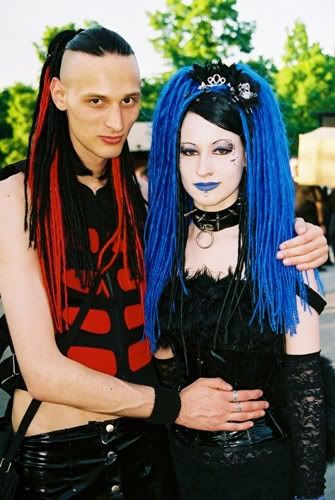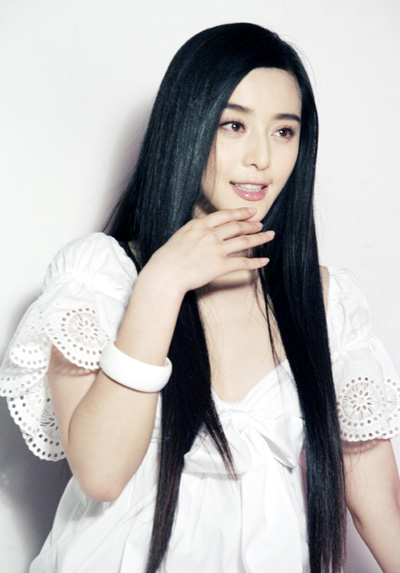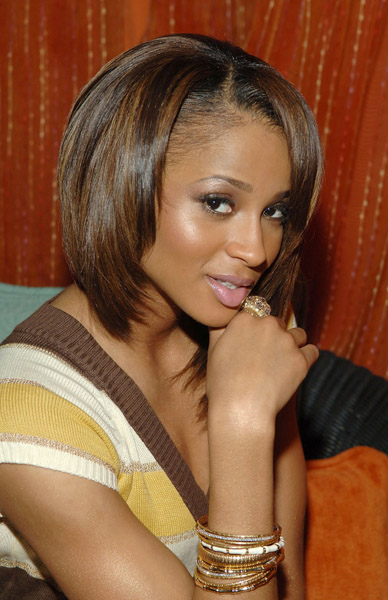Gothic fashion is a clothing style worn by members of the Goth subculture; a dark, sometimes morbid, eroticized fashion and style of dress.[1] Typical Gothic fashion includes dyed black hair, black lips and black clothes.[1] Both male and female goths wear dark eyeliner and dark fingernails. Styles are often borrowed from the Punks, Victorians and Elizabethans. BDSM imagery and paraphernalia are also common.[1] Some haute couture designers, particularly Alexander McQueen and John Galliano, have been associated with the goth aesthetic.
Cintra Wilson declares that "The origins of contemporary goth style are found in the Victorian cult of mourning."[2] Valerie Steele is an expert in the history of the style.[2]
Goth fashion can be recognized by its stark black clothing (or hair or makeup),[1] The style initially emerged alongside the early 1980s Gothic rock scene. Simon Reynolds identifies the usual appearance of
“ deathly pallor, backcombed or ratted black hair, ruffled Regency shirts, stovepipe hats, leather garments, spiked dog collars, the ensemble accessorized with religious, magical or macabre jewellery (bone earrings, rosaries, pentacles, ankhs, skulls), typically made from silver.[3] ”
Reynolds also notes "fishnet stockings, black leather thigh boots, [and] witchy eye make-up."[4]
Ted Polhemus described goth fashion as a
“ profusion of black velvets, lace, fishnets and leather tinged with scarlet or purple, accessorized with tightly laced corsets, gloves, precarious stilettos and silver jewelry depicting religious or occult themes.[5] ”
Researcher Maxim W. Furek noted,
“ Goth is a revolt against the slick fashions of the 1970’s disco era and a protest against the colorful pastels and extravagance of the 1980’s. Black hair, dark clothing and pale complexions provide the basic look of the Goth Dresser. One can paradoxically argue that the Goth look is one of deliberate overstatement as just a casual look at the heavy emphasis on dark flowing capes, ruffled cuffs, pale makeup and dyed hair demonstrate a modern- day version of late Victorian excess.[6]
Cintra Wilson declares that "The origins of contemporary goth style are found in the Victorian cult of mourning."[2] Valerie Steele is an expert in the history of the style.[2]
Goth fashion can be recognized by its stark black clothing (or hair or makeup),[1] The style initially emerged alongside the early 1980s Gothic rock scene. Simon Reynolds identifies the usual appearance of
“ deathly pallor, backcombed or ratted black hair, ruffled Regency shirts, stovepipe hats, leather garments, spiked dog collars, the ensemble accessorized with religious, magical or macabre jewellery (bone earrings, rosaries, pentacles, ankhs, skulls), typically made from silver.[3] ”
Reynolds also notes "fishnet stockings, black leather thigh boots, [and] witchy eye make-up."[4]
Ted Polhemus described goth fashion as a
“ profusion of black velvets, lace, fishnets and leather tinged with scarlet or purple, accessorized with tightly laced corsets, gloves, precarious stilettos and silver jewelry depicting religious or occult themes.[5] ”
Researcher Maxim W. Furek noted,
“ Goth is a revolt against the slick fashions of the 1970’s disco era and a protest against the colorful pastels and extravagance of the 1980’s. Black hair, dark clothing and pale complexions provide the basic look of the Goth Dresser. One can paradoxically argue that the Goth look is one of deliberate overstatement as just a casual look at the heavy emphasis on dark flowing capes, ruffled cuffs, pale makeup and dyed hair demonstrate a modern- day version of late Victorian excess.[6]
Gothic fashion is a clothing style worn by members of the Goth subculture; a dark, sometimes morbid, eroticized fashion and style of dress.[1] Typical Gothic fashion includes dyed black hair, black lips and black clothes.[1] Both male and female goths wear dark eyeliner and dark fingernails. Styles are often borrowed from the Punks, Victorians and Elizabethans. BDSM imagery and paraphernalia are also common.[1] Some haute couture designers, particularly Alexander McQueen and John Galliano, have been associated with the goth aesthetic.
Cintra Wilson declares that "The origins of contemporary goth style are found in the Victorian cult of mourning."[2] Valerie Steele is an expert in the history of the style.[2]
Goth fashion can be recognized by its stark black clothing (or hair or makeup),[1] The style initially emerged alongside the early 1980s Gothic rock scene. Simon Reynolds identifies the usual appearance of
“ deathly pallor, backcombed or ratted black hair, ruffled Regency shirts, stovepipe hats, leather garments, spiked dog collars, the ensemble accessorized with religious, magical or macabre jewellery (bone earrings, rosaries, pentacles, ankhs, skulls), typically made from silver.[3] ”
Reynolds also notes "fishnet stockings, black leather thigh boots, [and] witchy eye make-up."[4]
Ted Polhemus described goth fashion as a
“ profusion of black velvets, lace, fishnets and leather tinged with scarlet or purple, accessorized with tightly laced corsets, gloves, precarious stilettos and silver jewelry depicting religious or occult themes.[5] ”
Researcher Maxim W. Furek noted,
“ Goth is a revolt against the slick fashions of the 1970’s disco era and a protest against the colorful pastels and extravagance of the 1980’s. Black hair, dark clothing and pale complexions provide the basic look of the Goth Dresser. One can paradoxically argue that the Goth look is one of deliberate overstatement as just a casual look at the heavy emphasis on dark flowing capes, ruffled cuffs, pale makeup and dyed hair demonstrate a modern- day version of late Victorian excess.[6]
Cintra Wilson declares that "The origins of contemporary goth style are found in the Victorian cult of mourning."[2] Valerie Steele is an expert in the history of the style.[2]
Goth fashion can be recognized by its stark black clothing (or hair or makeup),[1] The style initially emerged alongside the early 1980s Gothic rock scene. Simon Reynolds identifies the usual appearance of
“ deathly pallor, backcombed or ratted black hair, ruffled Regency shirts, stovepipe hats, leather garments, spiked dog collars, the ensemble accessorized with religious, magical or macabre jewellery (bone earrings, rosaries, pentacles, ankhs, skulls), typically made from silver.[3] ”
Reynolds also notes "fishnet stockings, black leather thigh boots, [and] witchy eye make-up."[4]
Ted Polhemus described goth fashion as a
“ profusion of black velvets, lace, fishnets and leather tinged with scarlet or purple, accessorized with tightly laced corsets, gloves, precarious stilettos and silver jewelry depicting religious or occult themes.[5] ”
Researcher Maxim W. Furek noted,
“ Goth is a revolt against the slick fashions of the 1970’s disco era and a protest against the colorful pastels and extravagance of the 1980’s. Black hair, dark clothing and pale complexions provide the basic look of the Goth Dresser. One can paradoxically argue that the Goth look is one of deliberate overstatement as just a casual look at the heavy emphasis on dark flowing capes, ruffled cuffs, pale makeup and dyed hair demonstrate a modern- day version of late Victorian excess.[6]


















No comments:
Post a Comment